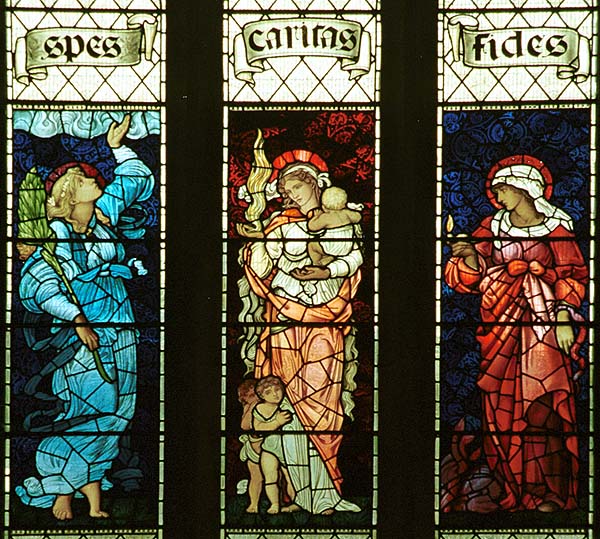Founding Mothers & Fathers of the United States were trained in Virtues, literally, as children. It was foundational to their education. See books by Bill Bennett. The Virtues led and formed the framework in their alphabetical training, reading, and writing. It does not bode well, this practice & these virtues have fallen out of practice/ fashion in their creation, imho.
In Christian philosophy, theological virtues are the character qualities associated with salvation. The three theological virtues are:
- Faith – steadfastness in belief.
- Hope – expectation of and desire of receiving; refraining from despair and capability of not giving up.
- Love – selfless, unconditional, and voluntary loving-kindness such as helping one’s neighbors.
They occur in the Bible at 1 Corinthians 13:13.
In Catholic theology, it is held that these virtues differ from the Cardinal Virtues in that they can not be obtained by human effort. A person can only receive them by their being “infused”—through Divine grace—into the person.
The theological virtues are so named because the object of these virtues is the divine being (theos). Other virtues have vice at their extremes, and are only virtues when they are maintained between these extremes. In the case of the Theological Virtues, they do not contribute to vice at the positive extreme; that is, there is no vice in having an unlimited amount of faith, hope, or love, when God is the object of that virtue. (Ed. There is no such thing as “too much of a good thing” with the Theological Virtues, as their ultimate aim is God, Himself.)
More than one vice can be the opposite of each theological virtue:
- Lack of faith may give place to incredulity (as in atheism and agnosticism), blasphemy or apostasy.
- Lack of hope may give place to despair or cynicism.
- Lack of love may give place to hatred, wrath or indifference.
Symbolism:
Theological Virtues are often depicted in art as young women. The symbols most often associated with them are:
Faith – cross, pointing upward, staff and chalice, lamp, candle
Hope – anchor, harp, flaming brand, palm
Charity – flaming heart, with children, gathering fruit

-by Br John Sica, OP
“St. Thomas Aquinas explains the fittingness of the Incarnation in several reasons, including how it raises our minds and hearts to an increase in faith, hope, and charity. Here I highlight a few of these reasons with respect to the Nativity of Christ and its manifestation.
1. Faith.
Faith, as St. Thomas defines it, is the habit of the mind whereby eternal life is begun in us, making the will assent to what is non-apparent. Faith rests in God as First Truth Speaking. St. Thomas says that faith “is made more certain by believing God Himself Who speaks.” In Jesus Christ, we literally hear God’s own words, from His own mouth. St. Augustine says that, “In order that man might journey more trustfully toward the truth, the Truth itself, the Son of God, having assumed human nature, established and founded faith.”
But note that Jesus became an object of faith before He began His public ministry. Indeed, Simeon takes the child Jesus in his arms and proclaims Him “a light for revelation to the Gentiles” (Lk 2:32). St. Thomas says that “the Magi were the ‘first-fruits of the Gentiles,’ who were to believe in Christ.” Simeon’s prophecy was already fulfilled in the Magi, who sought Him in response to the sign of the star and who did Him homage.
2. Hope.
Consider what hope is. The theological virtue of hope relies firmly on God for what is necessary for eternal life. In hope, our human will clings to the goodness of God for us. Augustine says, “Nothing was so necessary for raising our hope as to show us how deeply God loved us. And what could afford us a stronger proof of this than that the Son of God should become a partner with us of human nature?” Why should the Incarnation correspond to hope, as St. Augustine suggests? In hope, we formally depend on God’s merciful omnipotence: that He is omnipotent shows us that He can save us, and that He is merciful—as shown by the Incarnation—shows us that He wants to.
In the Incarnation, God pulls out all the stops. One Dominican commentator has noted that “no greater way is intelligible by which God could communicate Himself to the creature” than by uniting human nature to His Person. Seeing the Christ child in the manger, we know that God took the most extreme means to save us from sin, and we have confidence that He will continue to offer us the means to be rescued from our sin and given sanctifying grace.
3. Love.
While hope clings to God as good for us, charity clings to God as good in Himself. The divine goodness is what primarily motivates us to charity. But secondarily, St. Thomas explains, it is aimed at “other reasons that inspire us with love for Him, or which make it our duty to love Him,” and these “are secondary and result from the first.” The Incarnation is the greatest of these secondary reasons. The history of Christ’s Nativity and infancy counts powerfully towards this. Seeing that Christ became a weak and helpless infant becomes, for us, a motive to love in return. As Augustine said, “If we have been slow to love, at least let us hasten to love in return.”
Love breaks forth in acts of joy and peace. We experience joy in the possession of the good and peace when we are at concord, even within ourselves. At the Nativity the angels announce good news of a “great joy” (Lk 2:10), and their hymn of praise wishes “peace” among men of good will (Lk 2:14). All of this is because the Savior is born in the city of David, whose Nativity incites us to the acts and effects of love.”
Love,
Matthew

